MSI GT70 Review: GTX 880M Edition
by Jarred Walton on April 16, 2014 6:00 AM ESTMSI GT70 GTX 880M Gaming Performance
We’re at the point now where the fastest mobile GPUs can run just about everything at maxed out settings. There are a few exceptions, e.g. Metro Last Light will need to drop a setting or two to stay above 30FPS at 1080p, but the GTX 880M – and even the previous generation GTX 780M – are fast enough that some games are running into CPU limitations. That’s not really a problem in practice, since games that are CPU limited tend to still hit 60+ FPS, and if you’re running at lower detail settings just to show CPU bottlenecks it’s an artificial constraint.
Anyway, if you happen to have a system with a GTX 880M paired with an i7-4700MQ and you compare performance to a GTX 780M with an i7-4930XM, you’ll find instances where the faster CPU wins out. At our Mainstream and Enthusiast settings, however, all of the games we currently use for testing favor the faster GPU over a faster CPU. We’ve included results from some of the fastest notebooks we tested during the previous year for comparison. I’m only going to post charts of our Enthusiast settings, as anyone buying a notebook with a GTX 880M inherently qualifies as a gaming enthusiast in my book, but you can find the Mainstream and even Value scores in Mobile Bench (though the Value scores in particular are mostly meaningless).
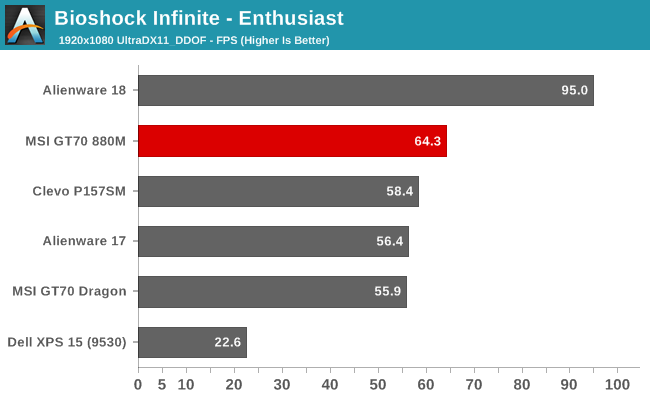
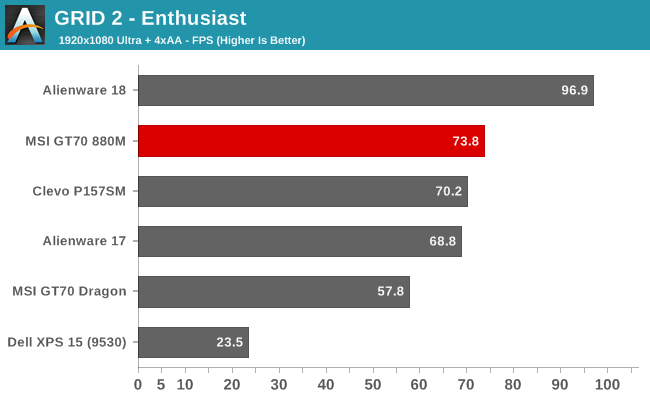
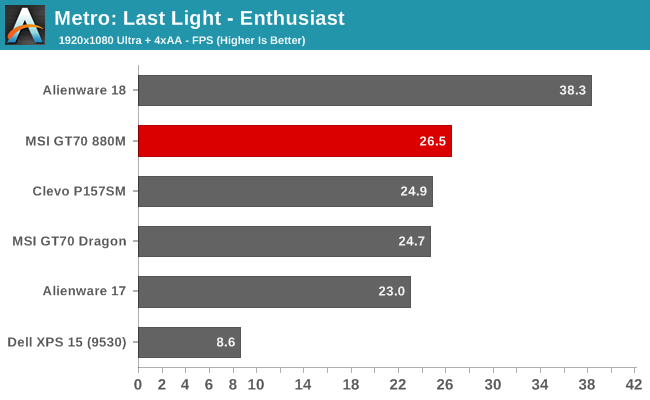
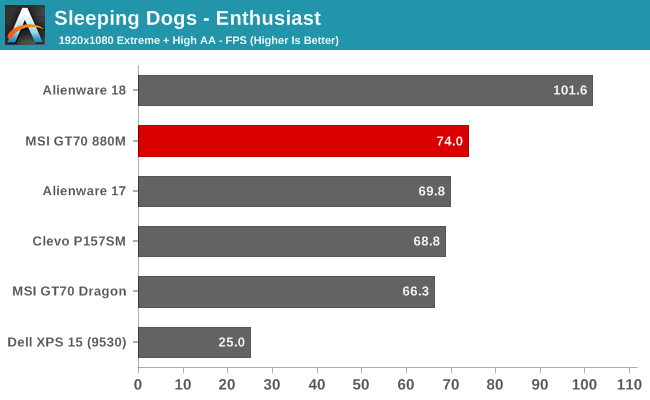
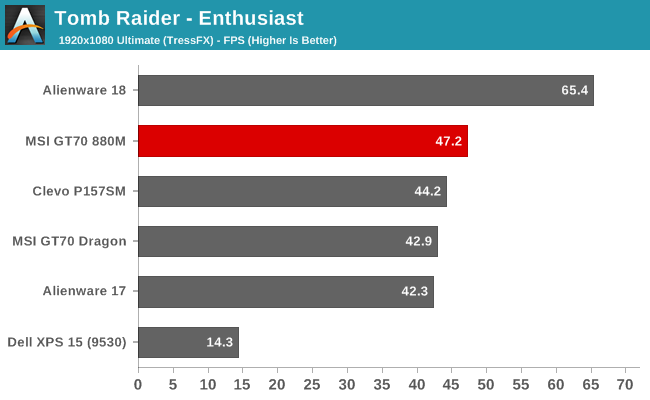
In their launch materials, NVIDIA claimed the new GTX 880M as being 15% faster than last year’s GTX 780M. Overall, our results with the GT70 compared to the Clevo P157SM or the previous GT70 Dragon don’t really agree with that figure, though it varies by game. It’s more accurate to state that the 880M is “up to 15% faster” rather than a 15% increase on average. The 880M boasts core clocks that are around 16% faster than the 780M, but memory bandwidth is the same so titles where the memory bandwidth comes into play (which is most games when we’re running at high/max details) will see quite a bit less than the maximum 16% increase in performance. The 880M does come with 8GB GDDR5 RAM, so there may be a few instances where the additional memory can help slightly, but right now most games are still targeting 4GB or less VRAM as the vast majority of GPUs shipped fall into that classification.
Overall, if we take the better result of the MSI GT70 Dragon and Clevo P157SM (on the assumption that driver differences may have negatively affected a few titles), the new GTX 880M ends up around 7% faster than the GTX 780M. It's not too surprising, considering we're looking at the same core architecture and the same memory bandwidth. 8GB VRAM is clearly more than the GTX 880M needs, at least with current titles; it might prove beneficial in the future, but I suspect by the time games are routinely using more than 4GB the 880M will be replaced by something newer/faster/better. While 7% isn't much of an improvement, keep in mind that the increase in cost (at least for an entire notebook) is only around $50. On an $1800 notebook that's a 3% increase, and considering the difficulty of acquiring a GPU upgrade for a notebook without buying a complete system, if you’re in the market for a gaming notebook the GT70 certainly offers a good value. If on the other hand you already own a gaming notebook with GTX 780M, you’ll likely want to wait for the inevitable “Big Maxwell” notebook GPUs to appear.










61 Comments
View All Comments
JarredWalton - Wednesday, April 16, 2014 - link
Crap... I could have sworn it had an IPS panel. Edited text, as you're right -- still TN. Does any 17.3" gaming notebook with PLS/IPS/AHVA exist right now? I've seen good displays in stuff like the EliteBook series, but those are apparently very expensive.pmpysz - Wednesday, April 16, 2014 - link
There's some new MSI notebooks with 3K screens. I think those are all versions of the GS60 and GT60s. There's also a 13.3 or 14" Eurocom model with a 1080p and 3k option. Then I saw a couple Gigabyte models with 1080p IPS in both 13" and 15" models. I think the 13" (P34G maybe) has newer 800 series, while the 15" doesn't, but will come out with a 800 series version soon. This is all off the top of my head though, so it might not be perfectly accurate. I personally really wanted an IPS ans the response time isn't as important to me as the image quality. I looked at the G750 at Best Buy and the TN panels look like garbage compared with everything I own. I really like the notebook, but no IPS really kills it for me.pmpysz - Wednesday, April 16, 2014 - link
*just to clarify, the 3Ks are all IPS AFIAK.rolla94 - Wednesday, April 16, 2014 - link
It is worth noting that the GT60 version uses what seems to be a Samsung PLS panel. I would be curious to see how the two panels compare. This is what I'm seeing on my GT60 Dominator 424 "SAMSUNG 156HL01-102"pmpysz - Wednesday, April 16, 2014 - link
Do all the GT60s use PLS? I've been curious as to what eDP wide angle means on some of the model descriptions. A quick google wrote it off as the same as TN, but I don't see how they can call TN wide anything.anactoraaron - Wednesday, April 16, 2014 - link
You guys going to get anything from a custom builder boutique based on the clevo w370ss chassis? That seems to hit a good price/performance point. Most boutique places are offering a free i7-4810 upgrade and I'm really wanting to see the 860m in some real world numbers.Hrel - Wednesday, April 16, 2014 - link
I don't think SSD's are as dramatic of a difference as you guys like to keep stating. Everything at work still uses hard drives. You launch everything and then just leave the computer on, with everything open, for weeks at a time. Once the programs are launched there's little/no difference between mechanical disks and SSD's. It's really not that bad.With that said when I power on the machine Monday morning I go make coffee cause I know it won't be usable for a few minutes. I think it's important to make that distinction, SSD is still just the difference between a "premium" experience and a normal one. The way most people use computers it's not a big deal. For anyone on a budget it's certainly not worth giving up meals over.
purerice - Wednesday, April 16, 2014 - link
I agree with you in the case of desktops. For laptops, however, the extra speed "can" increase battery life as well, or at least improve that portion of battery life where you are actually working. SSDs also weigh minutely less. Is that worth decreased capacity and extra cost?For you and for me, no, not really. For enough other people out there, yes.
JarredWalton - Wednesday, April 16, 2014 - link
I haven't really seen a major improvement in battery life thanks to SSDs (though it might happen in some cases). But the speed difference for launching apps, installing software, booting Windows, resuming from hibernate, etc. is very, VERY noticeable to me. Perhaps it's that I'm now used to having an SSD, so when I load Chrome and open my 30+ default tabs and it doesn't take a minute or two for everything to come up, I'm happy. Could I live without an SSD? Yes, but for the cost I'd much rather have a system with a good SSD and drop the CPU or GPU down a notch as opposed to having a maxed out CPU/GPU and no SSD.emarston - Thursday, April 17, 2014 - link
I disagree, if you require encrypted drives as my job does and SSD makes all the difference. Believe me I notice it on my work machine everyday.